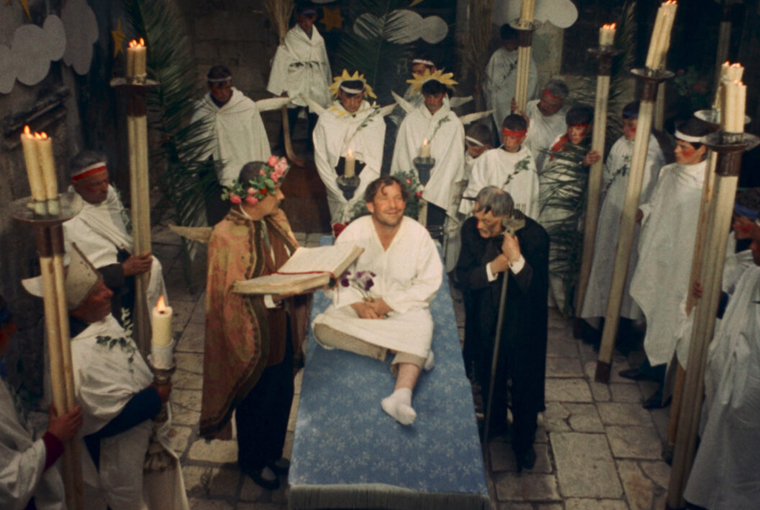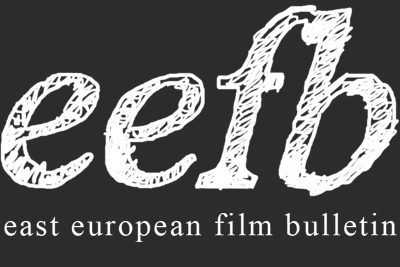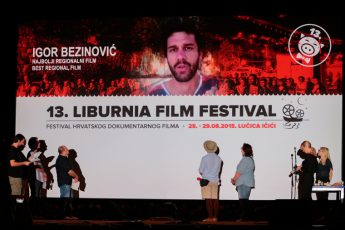Novi Film and Moral Antipodes
Vatroslav Mimica’s Kaja, I’ll Kill You! (Kaja, ubit ću te!, 1967)
Vol. 150 (December 2024) by Anna Doyle
The faded colors of the 1967 Croatian feature Kaja I’ll Kill You! bring a nostalgic dalmatian mood to the screen at the 2025 Rotterdam Film Festival. This unusual and forgotten semi-fictional/semi-abstract war film is somehow out of place amongst the cutting-edge Rotterdam competition. The movie differs from what one is accustomed to in Balkan cinema: it lacks the black humor of the Yugoslav Black Wave and if folkloric themes are present, they are unlike the exuberant adventures of a Slobodan Šijan film or Emir Kusturica’s gypsy comedies. The film has hardly been written about in Western Europe and is very rarely shown – despite it being a canonical part of Croatian cinema history and a classic of the Novi Film (New Wave) tendencies in Yugoslavia (1961–1972). The film has all the elements of a Yugoslav war drama yet always moves away from mere historical reconstruction. Rather, it privileges a poetic experimental take on the reality of war, exploring themes surrounding the nature of human evil and the battle between moral and aesthetic antipodes.
According to Daniel J. Goulding, the New Wave or Novi Film sparked a heated discussion amongst the vanguard of Yugoslav film critics in the 1960s. Goulding describes Novi Film as advocating four things:1
1) to increase the latitude for individual and collective artistic expression and to free film form dogmatism and bureaucratic control; 2) to promote stylistic experimentation in film form and film language – influenced initially by early 1960s films associated with French nouvelle vague and vanguard Italian cinema and later in the sixties by new wave tendencies in Eastern European countries, most notably Czechoslovakia and Poland; 3) to involve film in the expression of savremene teme (contemporary themes), including the right to critique the darker, ironic, alienated and gloomier side of human, societal, and political existence; and 4) to do all of these things within the context and premises of a Marxist-socialist state – at a time in Yugoslavia’s evolution when these very premises were a focal point for heated philosophical and ideological debate.
Vatroslav Mimica, the director of Kaja, seems to tick all these boxes. His stylistic fragmentation of film form, his interest in the cracks of collective life under state control, the critique of the dark sides of political existence, and his search for a pre-Marxist Adriatic mood hindered by Yugoslav ideology make his films a perfect example of what Goulding describes in the quote above. Mimica studied at the Faculty of Medicine in Zagreb and since 1942, he had been a member of the banned League of Socialist Youth of Yugoslavia (SKOJ), an anti-fascist youth organization which continued to function clandestinely from 1921 onwards and throughout WWII before the liberation of Yugoslavia in 1945. After his own experience of fighting in the war, Mimica worked as a literary and theater critic, and was one of the editors of the magazine Izvori. Later, upon achieving his artistic goals, he established himself as one of the leaders of the famous avant-garde Zagreb School of Animated film. He then pursued a career in feature filmmaking, adopting a professional modernist style aimed at a mass audience but which appears, at times, almost experimental, reminding us of some of the amateur filmmakers of the Split film club such as Ivan Martinac.2
Mimica’s film opens with abstract shots of a lugubrious urban atmosphere of spider webs, ruined stone houses riddled by cracks, and ghostly empty streets. These bleak shots contrast drastically with the subsequent twenty minutes of the film, as the film then makes the spectator experience the peaceful collective lifestyle of a Croatian town standing between the sun, the stone, and the sea. A time capsule of the past, children run down stone-paved narrow streets and innocently play in the pristine sea, while reassuring masculine presences walk around at a calm pace, with their voices slowly beginning to meet in song, bringing an ethnographic quality to the film. The preservation of masculine solidarity through polyphonic singing recalls Otar Iosseliani’s 1969 documentary Georgian Ancient Songs, where men across different regions of Georgia are seen singing collectively.
After the titles, which are superimposed on images of religious icons, we witness a medieval morality play, where children are wearing angel’s wings and men wear flower crowns in their hair, conveying a catholic and traditional atmosphere untouched by evil. Yet, as the birds repetitively fly over the town, sooner or later, the overall calmness feels disturbed by bad omens. Thus the fascist element is introduced. The tranquil and nostalgic Croatian world is slowly overshadowed by a pervasive threat as a group of Italian Blackshirts step in. The forced still shots and excessive zooming into beautiful flowers, seahorses under the sea, women sewing, pink skies, and Mediterranean sunsets on the seascapes enhance the idea that perhaps the place is too harmonious, with the amicability between the children and adults also appearing too smooth, as if it could not last and the beginning of the film was just a projected ideal.
This bloodless world is interrupted when one of the men is shot and the camera zooms in on a close-up of the blood shedding on the stone walls of the city. Now, the group of the Italian fascist regiment performing Nazi salutes march in: the rigidity and military gravity of the soldiers, although menacing, seems almost ridiculous. They do not seem to embody a historical reality but rather an archetypical human evil, which contrasts drastically with the steady beauty of the town. The film constantly builds on a duality reinforced by its experimental montage: the battle between harmony and violence, between innocence and pure evil. The opening scene representing a medieval morality play is therefore crucial to understanding the allegorical aspect of the film: just like in this film, in morality plays moral qualities (such as charity or vice) and existential concepts (like death or youth) are personified through archetypal characters that thus transport a moral message. The allegorical aspect of the film brings to mind other types of poetic films in the Eastern Europe of the time, such as the films of the Ukrainian Poetic School – notably those of Yuri Ilyenko. Apart from being involved in Paradjanov’s projects as a cinematographer, he made films such as A Spring for the Thirsty (Krynytsya dlya sprahlykh, 1965), under-titled “A Contemporary Parable,” which, although very different, also portrays allegorical characters that work more as abstractions than as full-fledged personalities, and where the ethnographic picture of traditional life interacts with the context of WWII.
A specific moment of desecration in the film is very striking. The fascists come into the town with their knives, singing vulgarly. They enter the church to destroy icons and sculptures, then loot the main historical building of the town, which contrasts with the shots of churches and icons at the beginning of the film. The film is based on duality thematically, rhythmically, and aesthetically, pinning the contrast between church life and secular fascist rituals, iconography/iconoclasm, the sacred/desecration. The theme of desecration could point to the general theme of iconology in ideological representations within Yugoslav culture. As one of the black uniformed characters puts his head through an old portrait of a historical figure in an administrative hall, all the other companions follow this violent frenzy, creating an exhilarating dance of cultural ravage and profanation. This is the most powerful moment of the film: an easy reading of the film would underline the pride of Yugoslav postwar culture against the fascist entities it fought during the Partisan war. Yet the film underscores the importance of cultural heritage, especially one based on images and the sacred, which poses an alternative not least to the iconology of Tito’s regime and its culture of heroism, in which portraits and monuments to the partisan struggle were part of a sort of secular religion. As Goulding stresses:3
Unlike other countries in Eastern Europe, Yugoslavia did not owe its liberation either to the Red Army or to Western forces. The Partisan war experience was the founding myth of the new Socialist Yugoslavia. Its heroic deeds, sacred songs, slogans, and icons were transformed into emblems of legitimacy for the postwar leadership.
He adds:
New film creators often offended the guardians of sanctioned traditions by reworking the substrata of collective experience into personal filmic visions and by infusing the past with the living present. They painted portraits of false heroes and of fallible Partisan warriors. They moved the viewer through troubling and ambiguous moral landscapes, where “right” and “truth” were not easily discerned.
The title “Kaja I’ll Kill You!” takes its name from the main character Kaja, an innocent shop keeper who childishly paints boats in his placid store and thereby epitomizes the naïve soul of the village. In his modest home, he entertains his friends, welcoming them with his jokes, stories, and with food. Kaja could be one of the existential false heroes Goulding talks about: his story is unimportant, he is almost secondary to the story’s plot, when the title seems to suggest that it is only his death that counts. Yet his death is not heroic and his normality contrasts with the official vision of the Yugoslav hero embodying defining characteristics of socialist ideology. At the end of the film, Piele, a local person from the town, joins the fascist regiment to become a soldier. Limping like a film noir gangster, he comes into his former friend’s shop and says, “Kaja, I’ll kill you.” No explanation or reasoning is given to this phrase. As if standing at a distance from any reality, the scene reveals the absurdity and automatism of murder. When the fascist points his gun at him, Kaja answers briefly in ironic approval, and as he runs out into the street, Piele kills him. The stark simplicity of the dialogue euphemizes the general absurdity of the war situation and more generally that of human evil. Kaja’s death, a meaningless stumble onto the street, recalls Jean-Paul Belmondo’s death in Breathless (1960), and despite the war context, lacks the dramatic and meaningful intensity of Anna Magnani’s death in the street in Rossellini’s Rome, Open City (1945). Hannah Arendt’s notorious “banality of evil” fits the movie well: evil does not seem to be driven by self-aware agency, but by structural violence inscribed not only in administrative and social constructs, but in the triviality of everyday life and human existence.
The film ends with the return of the same shots of cobwebs and ruins. Finally, an old, crippled man roams through the deserted ruins, moaning in agony. This character accentuates both the allegorical aspect of the film, whereby characters embody antipodal abstractions, and the idea of the absurdity of evil that qualifies many of the Novi films. If the film was as allegorical as a morality play, one could say, simply and naively: yes, virtue is better than evil, love is better than hate, beauty is better than ugliness. But as the film ends with this allegorical, almost-Shakespearian fool figure, Mimica stresses the farce of war and the uselessness of power-thirsty endeavors. As Goulding puts it, in Novi films what is right or wrong is not always discernible. Here the presence of evil pervades the seeming harmony of everyday life.
- Goulding, Daniel J. Liberated Cinema: The Yugoslav Experience. Indiana University Press, 1985; 66. ↩︎
- Martinac’s poetic and meditative approach to Adriatic lifestyles is arguably a more radical take on these new experiments that had been implemented in the early 1960s. See Frédéric Tachou’s article for EEFB: https://eefb.org/retrospectives/ivan-martinacs-monolog-on-split-monolog-o-splitu-1961-lordan-zafranovics-people-passing-ii-ljudi-u-prolazu-ii-1967/. ↩︎
- Goulding, 1985; 85. ↩︎




Leave a Comment